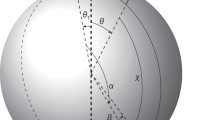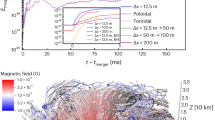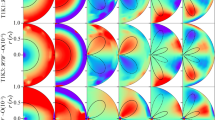Abstract
Magnetars are neutron stars (NSs) with extreme magnetic fields1 of strength 5 × 1013−1015 G. These fields are generated by dynamo action during the proto-NS phase, and are expected to have both poloidal and toroidal components2,3,4,5,6, although the energy of the toroidal component could be ten times larger7. Only the poloidal dipolar field can be measured directly, via NS spin-down8. The magnetic field provides heating and governs how this heat flows through the crust9. Magnetar thermal X-ray emission in quiescence is modulated with the rotational period of the NS, with a typical pulsed fraction 10–58%, implying that the surface temperature is substantially non-uniform despite the high thermal conductivity of the star’s crust. Poloidal dipolar fields cannot explain this large pulsed fraction10,11. Previous two-dimensional simulations12,13 have shown that a strong, large-scale toroidal magnetic field pushes a hot region into one hemisphere and increases the pulsed fraction. Here, we report three-dimensional magneto-thermal simulations of magnetars with strong, large-scale toroidal magnetic fields. These models, combined with ray propagation in curved spacetime, accurately describe the observed light curves of 10 out of 19 magnetars in quiescence and allow us to further constrain their rotational orientation. We find that the presence of a strong toroidal magnetic field is enough to explain the strong modulation of thermal X-ray emission in quiescence.
This is a preview of subscription content, access via your institution
Access options
Access Nature and 54 other Nature Portfolio journals
Get Nature+, our best-value online-access subscription
$29.99 / 30 days
cancel any time
Subscribe to this journal
Receive 12 digital issues and online access to articles
$119.00 per year
only $9.92 per issue
Buy this article
- Purchase on Springer Link
- Instant access to full article PDF
Prices may be subject to local taxes which are calculated during checkout


Similar content being viewed by others
Data availability
The data that support the plots within the paper and other findings are provided as Source data.
Code availability
The codes that were used to prepare our models within the paper are available from the corresponding authors upon reasonable request.
References
Kaspi, V. M. & Beloborodov, A. M. Magnetars. Annu. Rev. Astron. Astrophys. 55, 261–301 (2017).
Ferrario, L., Melatos, A. & Zrake, J. Magnetic field generation in stars. Space Sci. Rev. 191, 77–109 (2015).
Braithwaite, J. & Spruit, H. C. A fossil origin for the magnetic field in A stars and white dwarfs. Nature 431, 819–821 (2004).
Thompson, C., Lyutikov, M. & Kulkarni, S. R. Electrodynamics of magnetars: implications for the persistent X-ray emission and spin-down of the soft gamma repeaters and anomalous X-ray pulsars. Astrophys. J. 574, 332–355 (2002).
Lyutikov, M. & Gavriil, F. P. Resonant cyclotron scattering and Comptonization in neutron star magnetospheres. Mon. Not. R. Astron. Soc. 368, 690–706 (2006).
Rea, N., Zane, S., Turolla, R., Lyutikov, M. & Götz, D. Resonant cyclotron scattering in magnetars’ emission. Astrophys. J. 686, 1245–1260 (2008).
Braithwaite, J. & Nordlund, Å. Stable magnetic fields in stellar interiors. Astron. Astrophys. 450, 1077–1095 (2006).
Gunn, J. E. & Ostriker, J. P. Magnetic dipole radiation from pulsars. Nature 221, 454–456 (1969).
Pons, J. A. & Viganò, D. Magnetic, thermal and rotational evolution of isolated neutron stars. Living Rev. Comput. Astrophys. 5, 3 (2019).
Özel, F., Psaltis, D. & Kaspi, V. M. Constraints on thermal emission models of anomalous X-ray pulsars. Astrophys. J. 563, 255–266 (2001).
Hu, C.-P., Ng, C. Y. & Ho, W. C. G. A systematic study of soft X-ray pulse profiles of magnetars in quiescence. Mon. Not. R. Astron. Soc. 485, 4274–4286 (2019).
Perna, R., Viganò, D., Pons, J. A. & Rea, N. The imprint of the crustal magnetic field on the thermal spectra and pulse profiles of isolated neutron stars. Mon. Not. R. Astron. Soc. 434, 2362–2372 (2013).
Viganò, D. et al. Unifying the observational diversity of isolated neutron stars via magneto-thermal evolution models. Mon. Not. R. Astron. Soc. 434, 123–141 (2013).
Wood, T. S. & Hollerbach, R. Three-dimensional simulation of the magnetic stress in a neutron star crust. Phys. Rev. Lett. 114, 191101 (2015).
Gourgouliatos, K. N. & Hollerbach, R. Magnetic axis drift and magnetic spot formation in neutron stars with toroidal fields. Astrophys. J. 852, 21 (2018).
Gourgouliatos, K. N. & Pons, J. A. Nonaxisymmetric Hall instability: a key to understanding magnetars. Phys. Rev. Res. 1, 032049 (2019).
van Adelsberg, M. & Lai, D. Atmosphere models of magnetized neutron stars: QED effects, radiation spectra and polarization signals. Mon. Not. R. Astron. Soc. 373, 1495–1522 (2006).
Camilo, F., Reynolds, J., Johnston, S., Halpern, J. P. & Ransom, S. M. The magnetar 1E 1547.0-5408: radio spectrum, polarimetry, and timing. Astrophys. J. 679, 681–686 (2008).
Passamonti, A., Akgün, T., Pons, J. A. & Miralles, J. A. On the magnetic field evolution time-scale in superconducting neutron star cores. Mon. Not. R. Astron. Soc. 469, 4979–4984 (2017).
Gusakov, M. E., Kantor, E. M. & Ofengeim, D. D. Evolution of the magnetic field in neutron stars. Phys. Rev. D 96, 103012 (2017).
Riley, T. E. et al. A NICER view of PSR J0030+0451: millisecond pulsar parameter estimation. Astrophys. J. Lett. 887, L21 (2019).
Bilous, A. V. et al. A NICER view of PSR J0030+0451: evidence for a global-scale multipolar magnetic field. Astrophys. J. Lett. 887, L23 (2019).
Gourgouliatos, K. N., Wood, T. S. & Hollerbach, R. Magnetic field evolution in magnetar crusts through three-dimensional simulations. Proc. Natl Acad. Sci. USA 113, 3944–3949 (2016).
Dormy, E., Cardin, P. & Jault, D. MHD flow in a slightly differentially rotating spherical shell, with conducting inner core, in a dipolar magnetic field. Earth Planet. Sci. Lett. 160, 15–30 (1998).
Aubert, J., Aurnou, J. & Wicht, J. The magnetic structure of convection-driven numerical dynamos. Geophys. J. Int. 172, 945–956 (2008).
Gudmundsson, E. H., Pethick, C. J. & Epstein, R. I. Structure of neutron star envelopes. Astrophys. J. 272, 286–300 (1983).
Beloborodov, A. M. Gravitational bending of light near compact objects. Astrophys. J. Lett. 566, L85–L88 (2002).
Fruscione, A. et al. CIAO: Chandra’s data analysis system. Proc. SPIE 6270, 62701V (2006).
Olausen, S. A. & Kaspi, V. M. The McGill Magnetar Catalog. Astrophys. J. Suppl. Ser. 212, 6 (2014).
Cash, W. Parameter estimation in astronomy through application of the likelihood ratio. Astrophys. J. 228, 939–947 (1979).
Nelder, J. A. & Mead, R. A simplex method for function minimization. Comput. J. 7, 308–313 (1965).
Acknowledgements
We thank F. Verbunt for valuable comments that helped to improve our work notably. This work was supported by STFC grant no. ST/S000275/1. The numerical simulations were carried out on the STFC-funded DiRAC I UKMHD Science Consortia machine, hosted as part of and enabled through the ARC3 HPC resources and support team at the University of Leeds.
Author information
Authors and Affiliations
Contributions
All authors contributed to the simulation design, interpretation and writing the manuscript. A.P.I. carried out the X-ray data reduction, the MHD simulations and the model fitting. T.W. adapted the PARODY code to solve magneto-thermal equations.
Corresponding authors
Ethics declarations
Competing interests
The authors declare no competing interests.
Additional information
Peer review information
Nature Astronomy thanks Daniele Viganó and the other, anonymous, reviewer(s) for their contribution to the peer review of this work.
Publisher’s note Springer Nature remains neutral with regard to jurisdictional claims in published maps and institutional affiliations.
Extended data
Extended Data Fig. 1 Surface temperature, Ts, maps obtained for models with no initial toroidal magnetic field.
a, model C for NS with initial dipolar poloidal magnetic field B0 = 7 × 1013 G at age 10 kyr. b, model D for NS with initial poloidal dipolar magnetic field B0 = 5 × 1014 G age 10 kyr. The surface temperatures are in units of MK.
Extended Data Fig. 2 Results for model E with equal initial energy in toroidal and poloidal magnetic fields.
Panel A: surface temperature, Ts, maps obtained in 3D magneto-thermal simulations. We show NS with initial dipolar poloidal magnetic field B0 = 1 × 1014 G at age 10 kyr. Panels B, C, D: the soft X-ray light-curves expected for this thermal map at 10 kyr. Panel B shows k = 30∘ panel C shows k = 60∘ and panel D shows k = 90∘. Dotted black lines correspond to i = 30∘, solid blue lines correspond to i = 60∘ and red dashed lines correspond to i = 90∘.
Extended Data Fig. 3 The soft X-ray light-curves expected for models with no initial toroidal magnetic field.
Panels A, B, C are for model C, panels D,E,F are for model D. Panels A and D show k = 30∘, panels B and E show k = 60∘ and panels C and F show k = 90∘. Dotted black lines correspond to i = 30∘, solid blue lines correspond to i = 60∘ and red dashed lines correspond to i = 90∘.
Extended Data Fig. 4 Data sets analysed.
The instrument modes are as following: CC is the Continuous Clocking mode (2.85 msec time resolution), TE is the timed exposure (3.2 sec time resolution), PN has time resolution 73.4 msec in full frame mode and MOS has time resolution of 2.6 sec in full frame mode.
Extended Data Fig. 5 Folded soft X-ray light-curve (300-2000 eV) for magnetars.
A panel: PSR J1119-6127, B panel CXOU J164710.0-455216. Dashed blue lines show observations, and the theoretical light-curve for the most favourable orientation is shown with black solid lines. Red error bars are 1σ confidence intervals.
Extended Data Fig. 6 Folded soft X-ray light-curve (300-2000 eV) for magnetars.
A panel: XTE J1810-197, B panel Swift J1822.3-1606. Dashed blue lines show observations, and the theoretical light-curve for the most favourable orientation is shown with black solid lines. Red error bars are 1σ confidence intervals.
Extended Data Fig. 7 Folded soft X-ray light-curve (300-2000 eV) for magnetars.
A panel: CXOU J171405.7-381031, B panel SGR 1900+14. Dashed blue lines show observations, and the theoretical light-curve for the most favourable orientation is shown with black solid lines. Red error bars are 1σ confidence intervals.
Extended Data Fig. 8 Folded soft X-ray light-curve (300-2000 eV) for magnetars.
A panel: 4U 0142+61, B panel 1E 1841-045. Dashed blue lines show observations, and the theoretical light-curve for the most favourable orientation is shown with black solid lines. Red error bars are 1σ confidence intervals.
Extended Data Fig. 9 Folded soft X-ray light-curve (300-2000 eV) for magnetars.
A panel: SGR 0501+4516, B panel 3XMM J185246.6+003317. Dashed blue lines show observations, and the theoretical light-curve for the most favourable orientation is shown with black solid lines. Red error bars are 1σ confidence intervals.
Extended Data Fig. 10 Folded soft X-ray light-curve (300-2000 eV) for 1RXS J170849.0–400910.
The dashed blue lines and red error bars are observations and 1σ confidence intervals. The solid black lines are the theoretical light-curve for the most favourable orientation.
Source data
Rights and permissions
About this article
Cite this article
Igoshev, A.P., Hollerbach, R., Wood, T. et al. Strong toroidal magnetic fields required by quiescent X-ray emission of magnetars. Nat Astron 5, 145–149 (2021). https://doi.org/10.1038/s41550-020-01220-z
Received:
Accepted:
Published:
Issue Date:
DOI: https://doi.org/10.1038/s41550-020-01220-z
This article is cited by
-
Repeating fast radio burst 20201124A originates from a magnetar/Be star binary
Nature Communications (2022)
-
X-ray astronomy comes of age
Nature (2022)
-
The patchy temperature map of magnetars
Nature Astronomy (2020)



